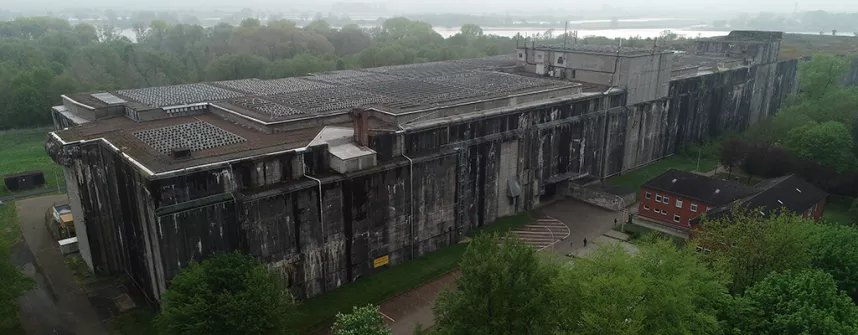Digitization of cultural heritage: researchers at Jacobs University Bremen create 3D maps of the submarine bunker Valentin
May 27, 2020
It was the largest armament project of the German war navy: Built mainly by forced laborers, the submarine bunker Valentin in Bremen-Farge is a noticeable reminder of the crimes of the Nazi dictatorship. An interdisciplinary research project at Jacobs University is digitally surveying the ruins, which house a memorial, using air, ground and underwater robots. First results of the project led by Andreas Birk, Professor of Electrical Engineering and Computer Science, are now available.
A theater performance in the memorial – the anti-war drama "The Last Days of Mankind" by Karl Kraus – first made Andreas Birk take a closer look at the building. He experienced the bunker as oppressive and depressing but also as scientifically challenging because of its history and dimensions. With a length of 426 meters, a width of up to 97 meters and a height of up to 33 meters, bunker Valentin is the largest free-standing bunker in Germany. Between 1943 and 1945, up to 12,000 forced laborers living in neighboring camps were deployed on the construction site every day. Many of them lost their lives. 1,700 deaths were officially registered; estimates assume a far higher number.
, An interdisciplinary research project at Jacobs University is digitally surveying the ruins, which house a memorial, using air, ground and underwater robots. (Source: Jacobs University, Robotics Group)Birk is interested in history, but as a scientist doing research on robots, he is mainly focused on technical issues. "How can you digitize such a huge complex with the help of robots? And how can you yet fuse the data with different acquisition methods to create 3D maps? That is an exciting topic," says Birk. The project, funded by the German Federal Ministry of Education and Research (BMBF), enables him to pursue these questions. The BMBF is funding the three-year project with around 600,000 euros as part of a program to digitize cultural heritage objects.
A 3D map of the outdoor area using flying drones has now been created. Inside, on the ground, robots with laser scanners are used, many areas are buried and difficult to access. Navigation under water is particularly demanding. "We use visual navigation as well as mapping, partly with cameras and partly with sonar," says Birk. "People would have no chance to orientate themselves in these conditions."
Surveying underwater spaces in very poor visibility conditions is one of the key challenges, says Birk. "There is still a lot of research needed." Another challenge is combining the data collected from the air, on the ground and underwater using different techniques. "In the meantime, we have noticed that the construction was hardly adhered to the plans, and in many cases, improvisation was used," says Birk. For example, the researchers discovered an undocumented basement room.
The historian Frederike Buda is part of the project team, too. Among others, she is involved in the review and digitization of 216 building plans. Buda also conducted a workshop at Jacobs University with various scholars on the digitization of testimonies of National Socialism. "That's the exciting thing for me: The combination of computer science and historical studies enables completely new forms of visualization and thus also of conveying historical topics," she says.
The data and 3D maps created in the project will be made available to the historical sciences and the general public. However, it is not a completed 3D model yet, with which visitors could go on a journey through time and move through the bunker. "We hope to realize this in a follow-up project," says Birk.
Questions are answered by:
Prof. Dr. Andreas Birk
Professor of Electrical Engineering & Computer Science
Email: a.birk [at] jacobs-university.de
Further information is available at:
http://robotics.jacobs-university.de/projects/Valentin3D
